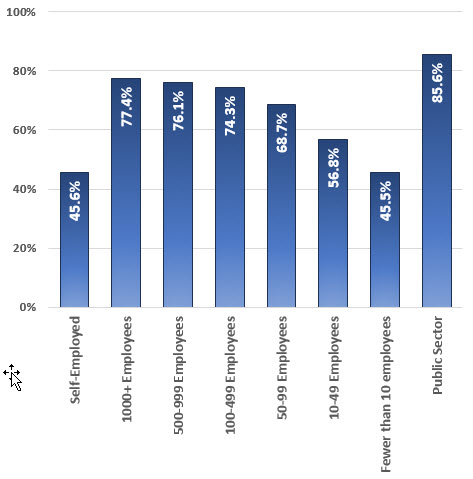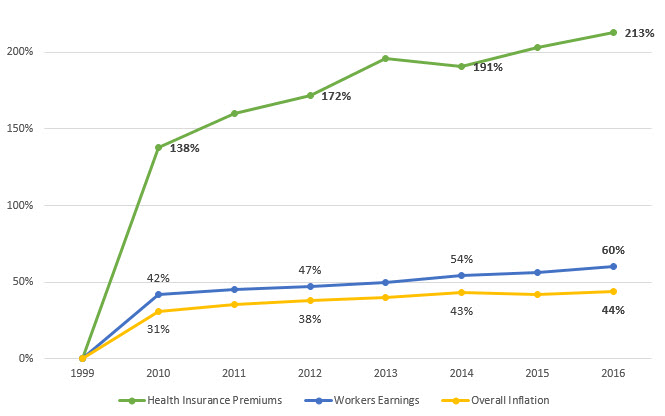NON-ELDERLY HEALTH INSURANCE COVERAGE | 2009-2011

*West North Central Census Division VI statistics includes data from Iowa, Kansas, Minesota, Missouri, Nebraska, North Dakota and South Dakota.
NOTE: Details may not add to totals because individuals may receive coverage from more than one source.
SOURCE: Employee Benefit Research Institute
EMPLOYMENT-BASED HEALTH INSURANCE COVERAGE | 2011
 |
NOTE: Firm size distributions include private sector workers only. Details may not add to totals because individuals may receive coverage from more than one source.
SOURCE: Employee Benefit Research Institute
|
HEALTH INSURANCE PREMIUM INCREASES| 2010-2016
The average family premium rose 3% over the 2015 average premium while the increase in the premium for single coverage was not statistically significant. The average premium for family coverage is lower for covered workers in small firms (3-199 workers) than for workers in large firms (200 or more workers) ($17,546 vs. $18,395). Workers' wages increased 2.5% and inflation increased 1.1% over the period. Premiums for family coverage have increased 20% since 2011 and 58% since 2006.

SOURCE: Kaiser/HRET Survey of Employer-Sponsored Health Benefits: 2016
HEALTH INSURANCE COVERAGE IN KANSAS| 2018
The percentage of uninsured Kansans for 2018 was 9 percent compared to 9 percent nationally. When comparing the uninsured population across the country, Kansas has a lower uninsured rate than 15 other states. National data suggest that males are more likely to be uninsured (14 percent) than females (11 percent). In Kansas, the percentage of males and females that are uninsured is 13 and 12 respectively. Fifty-five percent of the residents in Kansas receive employer-based insurance.

SOURCE: Urban Institute and Kaiser Foundation, estimates based on the Census Bureau's American Community Survey, 2008-2018.
NOTES*: Estimates with relative standard errors greater than 30% are not provided.
UNINSURED IN THE UNITED STATES AND KANSAS
In 2018, 8.5 percent of people, or 27.5 million, did not have health insurance at any point during the year. The uninsured rate and number of uninsured increased from 2017 (7.9 percent of 25.6 million).
Health Insurance Coverage in the United States: 2018
(Numbers in thousands)
Individuals are considered to be uninsured if they do not have health insurance coverage for the entire calendar year.
SOURCE: U.S.. Census Bureau, Current Population Survey, 2018 Annual Social and Economic Supplement Bridge File and 2019 Annual Social and Economic Supplement.
Kansas and United States: Health Insurance Coverage Children 0-18: 2018

Kansas: Uninsured Rates for the Non-elderly by Federal Poverty Level (FPL): 2018

SOURCE: Kaiser Family Foundation estimates based on the Census Bureau's American Community Survey, 2008-2018